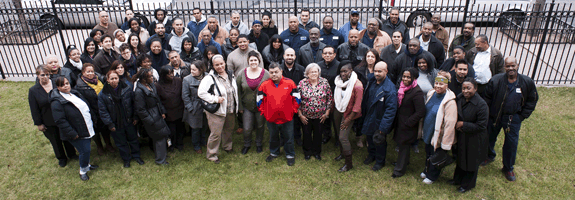By Zoe Jewell

In 1970s Brooklyn, says Deb Howard, “everybody kind of fled the city. Just like the Bronx was burning, we had the riots and the blackouts. In the 1980s, we had a crack epidemic and HIV.” Just twenty years later, the Fort Greene district where Deb works at the Pratt Area Community Council (PACC) is one of the most desirable in New York. It is just two stops from Wall Street, has a gorgeous park and huge brownstone houses which has made it enormously desirable to young professional workers unable to afford a Manhattan loft.
While in the 1970s, Deb and her colleagues were campaigning for a library, block watchers and cleaner parks; they now spend their time dealing with the consequences of a richer, gentrified neighbourhood. And they are often successfully protecting old-time residents from the negative effects garnered by gentrification.
I’ve now returned from my trip to Brooklyn, but there was this one interview left to post and it has been playing on my mind recently as discussion starts on the Somerleyton Rd developments. How do we work to ensure that the changes in Brixton Market and rising property rents don’t lead to widespread displacement and a loss of the diversity that makes Brixton so dear to our hearts? How to do that especially when it is so difficult – by the simple structures of our economy – to see how to stop people making personal choices about where and how they live? And how do we actually improve the situation for people in Brixton who have never had a great time of it anyway?
Pratt Area Community Council executive director Deb Howard has been doing community work in the Fort Greene area of Brooklyn since 1974 and I met her in their offices on De Kalb Avenue.
For the PACC, the key to their work is protecting tenants from high rents in an increasingly desirable area. She refers to a film made recently, ‘My Brooklyn’
, which she felt aptly demonstrated the dilemmas they are facing: “One thing the movie points out, which I kind of agree with, is that you can’t stop people from making individual decisions. If I was someone who bought my house in 1960 and I’m retired in 1995 and all of a sudden the house that I bought for $25,000 is now worth $850,000 or $1 million…you know, that’s what happened.
“When I think what it was like when I moved around the corner, but now it’s like couples with kids and dogs, and young people. You just wonder where they get their money! I don’t feel angry at them –
they came to a place that is a wonderful place to live. But what is often contradictory is that the cultural and ethnic character of the neighbourhood, which is what attracts so many people, is that if you can’t keep the mixed income, you’re not going to keep that character. Those who can afford to live here now are a very different racial, ethnic, economic mix. I mean you have a lot of young black people who are rich too, so it’s also an economic divide.”
Forte Greene was majority African-American until 2010. “There was a ‘white flight’ in the 1950s”, explains Deb, “when the suburbs were being developed and a large black population was moving up from the south – a lot of city workers, teachers, who were a minority ended up buying in the 1960s. So when you come around in the 2000s, they’re retiring. You have a lot of older homeowners.”
“Also the realtors pushed the values high by 2007. They’re back up again now.” A brownstone close to the PACC office just sold for $3million in one weekend. “It’s nuts”.
Much of PACC’s work, then, has not been directed at people making individual decisions – “we couldn’t really stop that gentrification” – but on ensuring that there is enough affordable housing in new developments and that, in the New York context, rent-controlled apartments remain rent-controlled.
“The problems we have run into with investors purchasing between 2000 and 2008 are huge. They tried to push out every old tenant that they could once they’d gone in even though there are tenant protections.”
Many brownstones in Brooklyn were rent controlled. But in 2004, New York state relaxed the rules so that a cap was put on the controlled rent. If you could get someone to rent above $2000 in a controlled apartment, which by Manhattan standards is not much, then the apartment could become decontrolled.
“So you had a tremendous incentive on the part of a new investor buying a building to push out the old tenants and then renovate the unit and they they put it back on the market at $2500. It’s over the $2000 cap, it’s within the market range of rents in the area.
“It basically triggered a whole push to get tenants out. So what we do – and we’ve actually been pretty successful at it – is that during the boom we kept track of sales and we’d go into buildings. We kept really close tabs on anyone who was served non-payment cases or was being harassed.”
Deb describes one particularly shocking case, when a tenant apparently went to live temporarily with her terminally-ill mother during the last few months of her life. She had her mail forwarded during that time and the new owners of the apartment used private investigators to start a case against her claiming that she no longer lived in the property.
Within a year of working to keep predatory investors accountable, PACC “had it down in terms of our outreach”. One of most successful techniques they used was to draw in new tenants in decontrolled flats so that they could present a united front against landlords. “We even had the new tenants challenging their rent increases. We wanted the new tenants to understand what was happening. A lot of them were young and, you know, they feel guilty about being the gentrifiers too, but it’s kind of a push that’s happening. It united the tenants. We got legal services involved representing buildings and we were able to stop a lot of rent increases.”
In other areas, PACC are also having some success, especially in pushing for ‘affordable’ rent (pegged to the area’s median income in New York) in new builds to be permanently affordable, rather than reverting to market rates after 35 years.
While the rent-controlling doesn’t apply directly to the situation in Brixton, the lesson from this remains pertinent – if residents can understand that rising rents and the loss of mixed income areas affects us all, whether we live in an ‘affordable’ unit at 50% of the market rent or in the most expensive house in Brixton, then perhaps – if we work hard – we can present a united front to make sure future developments like those at Somerleyton Rd don’t just benefit the relatively (or very) rich.
Look out for more on the Blog about Somerleyton Rd as the consultation progresses.







It’s actually a great and useful piece of information.
I am satisfied that you shared this helpful information with us.
Please stay us informed like this. Thank you for sharing.